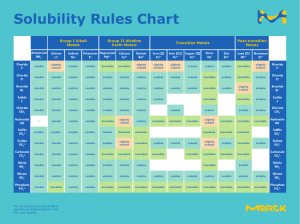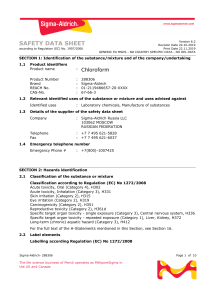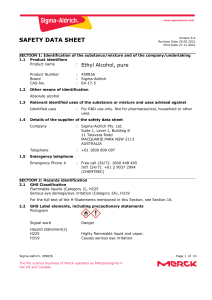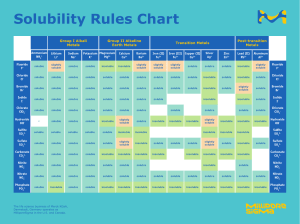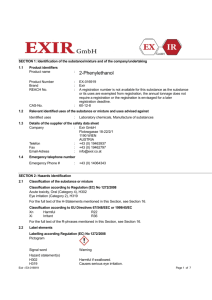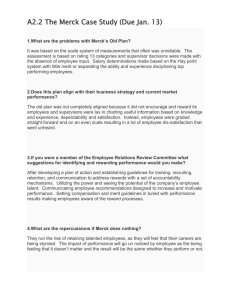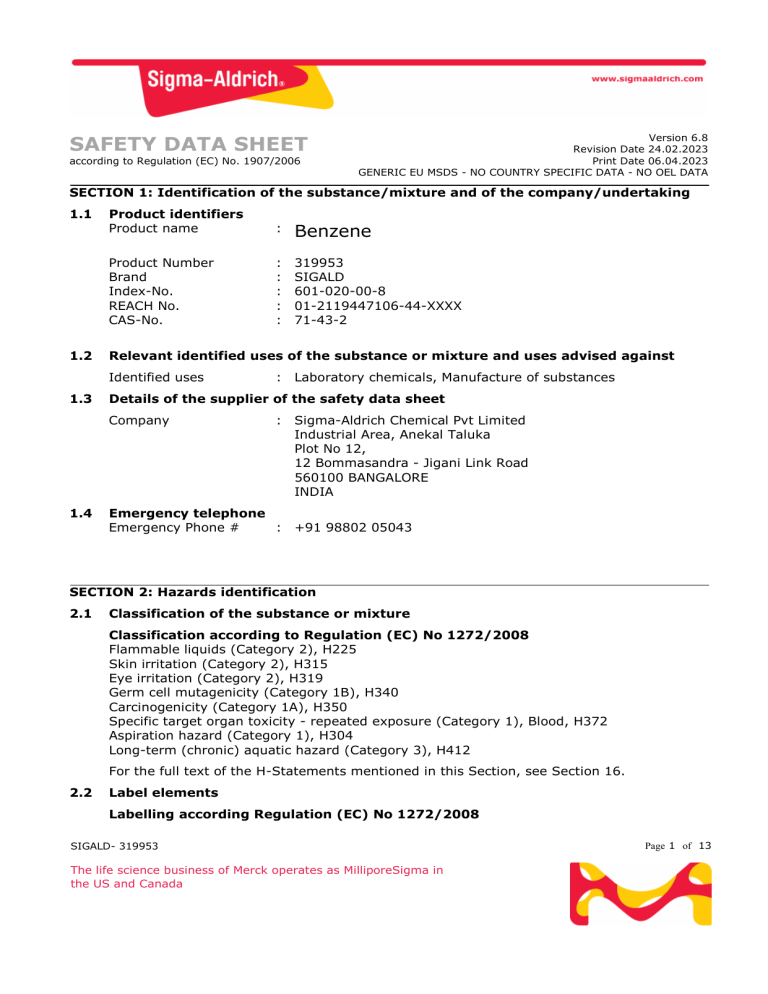
SAFETY DATA SHEET according to Regulation (EC) No. 1907/2006 Version 6.8 Revision Date 24.02.2023 Print Date 06.04.2023 GENERIC EU MSDS - NO COUNTRY SPECIFIC DATA - NO OEL DATA SECTION 1: Identification of the substance/mixture and of the company/undertaking 1.1 1.2 Product identifiers Product name : Benzene Product Number Brand Index-No. REACH No. CAS-No. : : : : : 319953 SIGALD 601-020-00-8 01-2119447106-44-XXXX 71-43-2 Relevant identified uses of the substance or mixture and uses advised against Identified uses 1.3 Details of the supplier of the safety data sheet Company 1.4 : Laboratory chemicals, Manufacture of substances : Sigma-Aldrich Chemical Pvt Limited Industrial Area, Anekal Taluka Plot No 12, 12 Bommasandra - Jigani Link Road 560100 BANGALORE INDIA Emergency telephone Emergency Phone # : +91 98802 05043 SECTION 2: Hazards identification 2.1 Classification of the substance or mixture Classification according to Regulation (EC) No 1272/2008 Flammable liquids (Category 2), H225 Skin irritation (Category 2), H315 Eye irritation (Category 2), H319 Germ cell mutagenicity (Category 1B), H340 Carcinogenicity (Category 1A), H350 Specific target organ toxicity - repeated exposure (Category 1), Blood, H372 Aspiration hazard (Category 1), H304 Long-term (chronic) aquatic hazard (Category 3), H412 For the full text of the H-Statements mentioned in this Section, see Section 16. 2.2 Label elements Labelling according Regulation (EC) No 1272/2008 SIGALD- 319953 The life science business of Merck operates as MilliporeSigma in the US and Canada Page 1 of 13 Pictogram Signal Word Hazard statement(s) H225 H304 H315 H319 H340 H350 H372 H412 Danger Highly flammable liquid and vapor. May be fatal if swallowed and enters airways. Causes skin irritation. Causes serious eye irritation. May cause genetic defects. May cause cancer. Causes damage to organs (Blood) through prolonged or repeated exposure. Harmful to aquatic life with long lasting effects. Precautionary statement(s) P210 Keep away from heat, hot surfaces, sparks, open flames and other ignition sources. No smoking. P273 Avoid release to the environment. P301 + P310 IF SWALLOWED: Immediately call a POISON CENTER/ doctor. P303 + P361 + P353 IF ON SKIN (or hair): Take off immediately all contaminated clothing. Rinse skin with water. P305 + P351 + P338 IF IN EYES: Rinse cautiously with water for several minutes. Remove contact lenses, if present and easy to do. Continue rinsing. P331 Do NOT induce vomiting. Supplemental Hazard Statements none Restricted to professional users. Reduced Labeling (<= 125 ml) Pictogram Signal Word Hazard statement(s) H340 H350 H372 H304 H412 Danger May cause genetic defects. May cause cancer. Causes damage to organs through prolonged or repeated exposure. May be fatal if swallowed and enters airways. Harmful to aquatic life with long lasting effects. Precautionary statement(s) P301 + P310 IF SWALLOWED: Immediately call a POISON CENTER/ doctor. P331 Do NOT induce vomiting. Supplemental Hazard Statements 2.3 none Other hazards This substance/mixture contains no components considered to be either persistent, bioaccumulative and toxic (PBT), or very persistent and very bioaccumulative (vPvB) at levels of 0.1% or higher. SIGALD- 319953 The life science business of Merck operates as MilliporeSigma in the US and Canada Page 2 of 13 SECTION 3: Composition/information on ingredients 3.1 Substances Formula Molecular weight CAS-No. EC-No. Index-No. : : : : : C6H6 78,11 g/mol 71-43-2 200-753-7 601-020-00-8 Component benzene CAS-No. EC-No. Index-No. Classification 71-43-2 200-753-7 601-020-00-8 Concentration Flam. Liq. 2; Skin Irrit. 2; <= 100 % Eye Irrit. 2; Muta. 1B; Carc. 1A; STOT RE 1; Asp. Tox. 1; Aquatic Chronic 3; H225, H315, H319, H340, H350, H372, H304, H412 For the full text of the H-Statements mentioned in this Section, see Section 16. SECTION 4: First aid measures 4.1 Description of first-aid measures General advice Show this material safety data sheet to the doctor in attendance. If inhaled After inhalation: fresh air. Call in physician. In case of skin contact In case of skin contact: Take off immediately all contaminated clothing. Rinse skin with water/ shower. Consult a physician. In case of eye contact After eye contact: rinse out with plenty of water. Call in ophthalmologist. Remove contact lenses. If swallowed After swallowing: caution if victim vomits. Risk of aspiration! Keep airways free. Pulmonary failure possible after aspiration of vomit. Call a physician immediately. 4.2 Most important symptoms and effects, both acute and delayed The most important known symptoms and effects are described in the labelling (see section 2.2) and/or in section 11 4.3 Indication of any immediate medical attention and special treatment needed No data available SECTION 5: Firefighting measures 5.1 Extinguishing media Suitable extinguishing media Carbon dioxide (CO2) Foam Dry powder SIGALD- 319953 The life science business of Merck operates as MilliporeSigma in the US and Canada Page 3 of 13 Unsuitable extinguishing media For this substance/mixture no limitations of extinguishing agents are given. 5.2 Special hazards arising from the substance or mixture Carbon oxides Flash back possible over considerable distance., Container explosion may occur under fire conditions. Combustible. Pay attention to flashback. Vapors are heavier than air and may spread along floors. Development of hazardous combustion gases or vapours possible in the event of fire. Forms explosive mixtures with air at ambient temperatures. 5.3 Advice for firefighters Stay in danger area only with self-contained breathing apparatus. Prevent skin contact by keeping a safe distance or by wearing suitable protective clothing. 5.4 Further information Remove container from danger zone and cool with water. Prevent fire extinguishing water from contaminating surface water or the ground water system. SECTION 6: Accidental release measures 6.1 Personal precautions, protective equipment and emergency procedures Advice for non-emergency personnel: Do not breathe vapors, aerosols. Avoid substance contact. Ensure adequate ventilation. Keep away from heat and sources of ignition. Evacuate the danger area, observe emergency procedures, consult an expert. For personal protection see section 8. 6.2 Environmental precautions Do not let product enter drains. Risk of explosion. 6.3 Methods and materials for containment and cleaning up Cover drains. Collect, bind, and pump off spills. Observe possible material restrictions (see sections 7 and 10). Take up carefully with liquid-absorbent material (e.g. Chemizorb®). Dispose of properly. Clean up affected area. 6.4 Reference to other sections For disposal see section 13. SECTION 7: Handling and storage 7.1 Precautions for safe handling Advice on safe handling Work under hood. Do not inhale substance/mixture. Avoid generation of vapours/aerosols. Advice on protection against fire and explosion Keep away from open flames, hot surfaces and sources of ignition.Take precautionary measures against static discharge. Hygiene measures Immediately change contaminated clothing. Apply preventive skin protection. Wash hands and face after working with substance. For precautions see section 2.2. 7.2 Conditions for safe storage, including any incompatibilities Storage conditions SIGALD- 319953 The life science business of Merck operates as MilliporeSigma in the US and Canada Page 4 of 13 Keep container tightly closed in a dry and well-ventilated place. Keep away from heat and sources of ignition. Keep locked up or in an area accessible only to qualified or authorized persons. Storage class Storage class (TRGS 510): 3: Flammable liquids 7.3 Specific end use(s) Apart from the uses mentioned in section 1.2 no other specific uses are stipulated SECTION 8: Exposure controls/personal protection 8.1 Control parameters Ingredients with workplace control parameters 8.2 Exposure controls Personal protective equipment Eye/face protection Use equipment for eye protection tested and approved under appropriate government standards such as NIOSH (US) or EN 166(EU). Safety glasses Skin protection Handle with gloves. Gloves must be inspected prior to use. Use proper glove removal technique (without touching glove's outer surface) to avoid skin contact with this product. Dispose of contaminated gloves after use in accordance with applicable laws and good laboratory practices. Wash and dry hands. The selected protective gloves have to satisfy the specifications of Regulation (EU) 2016/425 and the standard EN 374 derived from it. Full contact Material: Fluorinated rubber Minimum layer thickness: 0,7 mm Break through time: 480 min Material tested:Vitoject® (KCL 890 / Aldrich Z677698, Size M) Splash contact Material: Fluorinated rubber Minimum layer thickness: 0,7 mm Break through time: 480 min Material tested:Vitoject® (KCL 890 / Aldrich Z677698, Size M) data source: KCL GmbH, D-36124 Eichenzell, phone +49 (0)6659 87300, e-mail sales@kcl.de, test method: EN374 If used in solution, or mixed with other substances, and under conditions which differ from EN 374, contact the supplier of the EC approved gloves. This recommendation is advisory only and must be evaluated by an industrial hygienist and safety officer familiar with the specific situation of anticipated use by our customers. It should not be construed as offering an approval for any specific use scenario. Body Protection Flame retardant antistatic protective clothing. Respiratory protection Recommended Filter type: Filter A-(P3) SIGALD- 319953 The life science business of Merck operates as MilliporeSigma in the US and Canada Page 5 of 13 The entrepeneur has to ensure that maintenance, cleaning and testing of respiratory protective devices are carried out according to the instructions of the producer. These measures have to be properly documented. Control of environmental exposure Do not let product enter drains. Risk of explosion. SECTION 9: Physical and chemical properties 9.1 Information on basic physical and chemical properties a) Physical state liquid b) Color clear, colorless c) Odor No data available d) Melting point/freezing point Melting point/range: 5,5 °C - lit. e) Initial boiling point and boiling range 80 °C - lit. f) Flammability (solid, gas) No data available g) Upper/lower flammability or explosive limits Upper explosion limit: 8,0 %(V) Lower explosion limit: 1,2 %(V) h) Flash point -11 °C - DIN 51755 Part 1 i) Autoignition temperature 498 °C at 1.013,5 hPa j) Decomposition temperature No data available k) pH No data available l) Viscosity Viscosity, kinematic: 0,604 mm2/s at 25 °C Viscosity, dynamic: No data available m) Water solubility ca.1,88 g/l at 23,5 °C - soluble n) Partition coefficient: n-octanol/water log Pow: 2,13 at 25 °C - Bioaccumulation is not expected., (ECHA) o) Vapor pressure 100 hPa at 20 °C p) Density 0,874 g/cm3 at 25 °C - lit. Relative density No data available q) Relative vapor density No data available r) Particle characteristics No data available s) Explosive properties No data available SIGALD- 319953 The life science business of Merck operates as MilliporeSigma in the US and Canada Page 6 of 13 t) 9.2 Oxidizing properties none Other safety information No data available SECTION 10: Stability and reactivity 10.1 Reactivity Vapors may form explosive mixture with air. 10.2 Chemical stability The product is chemically stable under standard ambient conditions (room temperature) . 10.3 Possibility of hazardous reactions Exothermic reaction with: halogens Halogenated hydrocarbon in the presence of: Light metals Risk of explosion with: halogen-halogen compounds Nitric acid Boranes Ozone peroxi compounds perchlorates permanganic acid perchloryl fluoride Strong oxidizing agents Chlorine fluorides uranium hexafluoride Oxygen liquid Risk of ignition or formation of inflammable gases or vapours with: chromium(VI) oxide Fluorine nitryl compounds Oxygen oxyhalogenic compounds Violent reactions possible with: mineral acids sulfur 10.4 Conditions to avoid Warming. 10.5 Incompatible materials rubber, various plastics 10.6 Hazardous decomposition products In the event of fire: see section 5 SIGALD- 319953 The life science business of Merck operates as MilliporeSigma in the US and Canada Page 7 of 13 SECTION 11: Toxicological information 11.1 Information on toxicological effects Acute toxicity LD50 Oral - Rat - male - > 2.000 mg/kg (OECD Test Guideline 401) Symptoms: Nausea LC50 Inhalation - Rat - female - 4 h - 43,7 mg/l - vapor (OECD Test Guideline 403) LD50 Dermal - Rabbit - male and female - > 8.260 mg/kg (OECD Test Guideline 402) Skin corrosion/irritation Skin - Rabbit Result: Irritating to skin. - 4 h (OECD Test Guideline 404) Remarks: Drying-out effect resulting in rough and chapped skin. Serious eye damage/eye irritation Eyes - Rabbit Result: Eye irritation Remarks: (ECHA) Respiratory or skin sensitization Maximization Test - Guinea pig Result: negative (OECD Test Guideline 406) Germ cell mutagenicity May cause genetic defects. Test Type: Ames test Test system: Salmonella typhimurium Metabolic activation: with and without metabolic activation Method: OECD Test Guideline 471 Result: negative Test Type: Mutagenicity (mammal cell test): chromosome aberration. Test system: Chinese hamster lung cells Metabolic activation: with and without metabolic activation Method: US-EPA Result: positive Test Type: In vitro mammalian cell gene mutation test Metabolic activation: with and without metabolic activation Method: US-EPA Result: positive Test Type: Mutagenicity (mammal cell test): micronucleus. Species: Mouse Cell type: Bone marrow Application Route: inhalation (vapor) Method: OECD Test Guideline 474 Result: positive Carcinogenicity May cause cancer. Positive evidence from human epidemiological studies. Reproductive toxicity SIGALD- 319953 The life science business of Merck operates as MilliporeSigma in the US and Canada Page 8 of 13 No data available Specific target organ toxicity - single exposure No data available Specific target organ toxicity - repeated exposure Causes damage to organs through prolonged or repeated exposure. - Blood Aspiration hazard May be fatal if swallowed and enters airways. 11.2 Additional Information Endocrine disrupting properties Product: Assessment : The substance/mixture does not contain components considered to have endocrine disrupting properties according to REACH Article 57(f) or Commission Delegated regulation (EU) 2017/2100 or Commission Regulation (EU) 2018/605 at levels of 0.1% or higher. Repeated dose toxicity - Rat - male and female - Oral - 120 d - NOAEL (No observed adverse effect level) - 100 mg/kg - LOAEL (Lowest observed adverse effect level) - 25 mg/kg Remarks: Subchronic toxicity RTECS: CY1400000 Nausea, Dizziness, Headache, narcosis, Inhalation of high concentrations of benzene may have an initial stimulatory effect on the central nervous system characterized by exhilaration, nervous excitation and/or giddiness, depression, drowsiness, or fatigue. The victim may experience tightness in the chest, breathlessness, and loss of consciousness. Tremors, convulsions, and death due to respiratory paralysis or circulatory collapse can occur in a few minutes to several hours following severe exposures. Aspiration of small amounts of liquid immediately causes pulmonary edema and hemorrhage of pulmonary tissue. Direct skin contact may cause erythema. Repeated or prolonged skin contact may result in drying, scaling dermatitis, or development of secondary skin infections. The chief target organ is the hematopoietic system. Bleeding from the nose, gums, or mucous membranes and the development of purpuric spots, pancytopenia, leukopenia, thrombocytopenia, aplastic anemia, and leukemia may occur as the condition progresses. The bone marrow may appear normal, aplastic or hyperplastic, and may not correlate with peripheral blood-forming tissues. The onset of effects of prolonged benzene exposure may be delayed for many months or years after the actual exposure has ceased., Blood disorders To the best of our knowledge, the chemical, physical, and toxicological properties have not been thoroughly investigated. Systemic effects: After absorption: agitation Headache Dizziness inebriation Tiredness SIGALD- 319953 The life science business of Merck operates as MilliporeSigma in the US and Canada Page 9 of 13 CNS disorders narcosis respiratory arrest Subacute toxicity After a latency period: Changes in the blood count haemolysis Other dangerous properties can not be excluded. This substance should be handled with particular care. SECTION 12: Ecological information 12.1 Toxicity Toxicity to fish flow-through test LC50 - Oncorhynchus mykiss (rainbow trout) - 5,3 mg/l - 96 h (OECD Test Guideline 203) Toxicity to daphnia and other aquatic invertebrates static test EC50 - Daphnia magna (Water flea) - 10 mg/l - 48 h (OECD Test Guideline 202) Toxicity to algae static test ErC50 - Pseudokirchneriella subcapitata (green algae) 100 mg/l - 72 h (OECD Test Guideline 201) Toxicity to bacteria static test IC50 - - 13 mg/l - 24 h Remarks: (ECHA) 12.2 Persistence and degradability Biodegradability aerobic - Exposure time 28 d Result: 96 % - Readily biodegradable. (OECD Test Guideline 301F) 12.3 Bioaccumulative potential Bioaccumulation Leuciscus idus (Golden orfe) - 3 d - 0,05 mg/l(benzene) Bioconcentration factor (BCF): 10 12.4 Mobility in soil No data available 12.5 Results of PBT and vPvB assessment This substance/mixture contains no components considered to be either persistent, bioaccumulative and toxic (PBT), or very persistent and very bioaccumulative (vPvB) at levels of 0.1% or higher. 12.6 Endocrine disrupting properties Product: SIGALD- 319953 The life science business of Merck operates as MilliporeSigma in the US and Canada Page 10 of 13 Assessment : The substance/mixture does not contain components considered to have endocrine disrupting properties according to REACH Article 57(f) or Commission Delegated regulation (EU) 2017/2100 or Commission Regulation (EU) 2018/605 at levels of 0.1% or higher. 12.7 Other adverse effects Endangers drinking-water supplies if allowed to enter soil or water. Discharge into the environment must be avoided. SECTION 13: Disposal considerations 13.1 Waste treatment methods No data available SECTION 14: Transport information 14.1 UN number ADR/RID: 1114 IMDG: 1114 IATA: 1114 14.2 UN proper shipping name ADR/RID: BENZENE IMDG: BENZENE IATA: Benzene 14.3 Transport hazard class(es) ADR/RID: 3 IMDG: 3 IATA: 3 14.4 Packaging group ADR/RID: II IMDG: II IATA: II 14.5 Environmental hazards ADR/RID: no IMDG Marine pollutant: no IATA: no 14.6 Special precautions for user Tunnel restriction code : (D/E) Further information : No data available SECTION 15: Regulatory information 15.1 Safety, health and environmental regulations/legislation specific for the substance or mixture This material safety data sheet complies with the requirements of Regulation (EC) No. 1907/2006. Authorisations and/or restrictions on use REACH - Restrictions on the manufacture, placing on the market and use of certain dangerous substances, mixtures and articles (Annex XVII) : benzene National legislation Seveso III: Directive 2012/18/EU of the European : FLAMMABLE LIQUIDS Parliament and of the Council on the control of SIGALD- 319953 The life science business of Merck operates as MilliporeSigma in the US and Canada Page 11 of 13 major-accident hazards involving dangerous substances. Other regulations Observe work restrictions regarding maternity protection in accordance to Dir 92/85/EEC or stricter national regulations where applicable. Take note of Dir 94/33/EC on the protection of young people at work. 15.2 Chemical Safety Assessment For this product a chemical safety assessment was not carried out SECTION 16: Other information Full text of H-Statements referred to under sections 2 and 3. H225 H304 H315 H319 H340 H350 H372 H412 Highly flammable liquid and vapor. May be fatal if swallowed and enters airways. Causes skin irritation. Causes serious eye irritation. Highly flammable liquid and vapor. May be fatal if swallowed and enters airways. Causes skin irritation. Causes serious eye irritation. SIGALD- 319953 The life science business of Merck operates as MilliporeSigma in the US and Canada Page 12 of 13 Full text of other abbreviations ADN - European Agreement concerning the International Carriage of Dangerous Goods by Inland Waterways; ADR - Agreement concerning the International Carriage of Dangerous Goods by Road; AIIC - Australian Inventory of Industrial Chemicals; ASTM American Society for the Testing of Materials; bw - Body weight; CMR - Carcinogen, Mutagen or Reproductive Toxicant; DIN - Standard of the German Institute for Standardisation; DSL - Domestic Substances List (Canada); ECx - Concentration associated with x% response; ELx - Loading rate associated with x% response; EmS Emergency Schedule; ENCS - Existing and New Chemical Substances (Japan); ErCx Concentration associated with x% growth rate response; GHS - Globally Harmonized System; GLP - Good Laboratory Practice; IARC - International Agency for Research on Cancer; IATA - International Air Transport Association; IBC - International Code for the Construction and Equipment of Ships carrying Dangerous Chemicals in Bulk; IC50 - Half maximal inhibitory concentration; ICAO - International Civil Aviation Organization; IECSC - Inventory of Existing Chemical Substances in China; IMDG - International Maritime Dangerous Goods; IMO - International Maritime Organization; ISHL - Industrial Safety and Health Law (Japan); ISO - International Organisation for Standardization; KECI - Korea Existing Chemicals Inventory; LC50 - Lethal Concentration to 50 % of a test population; LD50 - Lethal Dose to 50% of a test population (Median Lethal Dose); MARPOL - International Convention for the Prevention of Pollution from Ships; n.o.s. Not Otherwise Specified; NO(A)EC - No Observed (Adverse) Effect Concentration; NO(A)EL - No Observed (Adverse) Effect Level; NOELR - No Observable Effect Loading Rate; NZIoC - New Zealand Inventory of Chemicals; OECD - Organization for Economic Co-operation and Development; OPPTS - Office of Chemical Safety and Pollution Prevention; PBT - Persistent, Bioaccumulative and Toxic substance; PICCS - Philippines Inventory of Chemicals and Chemical Substances; (Q)SAR - (Quantitative) Structure Activity Relationship; REACH - Regulation (EC) No 1907/2006 of the European Parliament and of the Council concerning the Registration, Evaluation, Authorisation and Restriction of Chemicals; RID - Regulations concerning the International Carriage of Dangerous Goods by Rail; SADT - Self-Accelerating Decomposition Temperature; SDS Safety Data Sheet; TCSI - Taiwan Chemical Substance Inventory; TECI - Thailand Existing Chemicals Inventory; TSCA - Toxic Substances Control Act (United States); UN - United Nations; UNRTDG - United Nations Recommendations on the Transport of Dangerous Goods; vPvB - Very Persistent and Very Bioaccumulative Further information The above information is believed to be correct but does not purport to be all inclusive and shall be used only as a guide. The information in this document is based on the present state of our knowledge and is applicable to the product with regard to appropriate safety precautions. It does not represent any guarantee of the properties of the product. Sigma-Aldrich Corporation and its Affiliates shall not be held liable for any damage resulting from handling or from contact with the above product. See www.sigma-aldrich.com and/or the reverse side of invoice or packing slip for additional terms and conditions of sale. Copyright 2020 Sigma-Aldrich Co. LLC. License granted to make unlimited paper copies for internal use only. The branding on the header and/or footer of this document may temporarily not visually match the product purchased as we transition our branding. However, all of the information in the document regarding the product remains unchanged and matches the product ordered. For further information please contact mlsbranding@sial.com. SIGALD- 319953 The life science business of Merck operates as MilliporeSigma in the US and Canada Page 13 of 13
